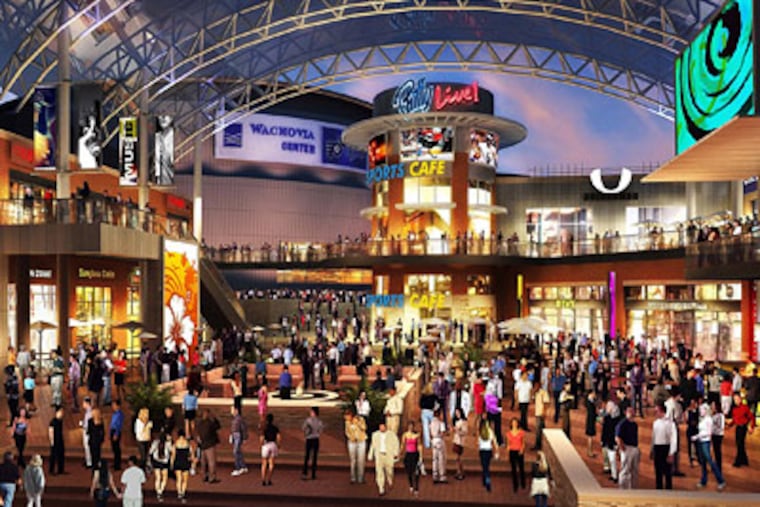A glitzy game plan for developing Spectrum site
A plan to bring life to the vast asphalt desert around Philadelphia's stadium complex moved forward yesterday when a Baltimore developer released drawings for a $100 million entertainment center that would provide easier connections among Wachovia Center, Citizens Bank Park, and Lincoln Financial Field.

A plan to bring life to the vast asphalt desert around Philadelphia's stadium complex moved forward yesterday when a Baltimore developer released drawings for a $100 million entertainment center that would provide easier connections among Wachovia Center, Citizens Bank Park, and Lincoln Financial Field.
The glitzy architectural renderings, presented to the city Planning Commission, showed a two-block-long, diagonal street lined with restaurants, bars, and shops. Modeled on such destinations as Boston's Quincy Market and Baltimore's Power Plant Live!, the partly enclosed street linking the sports venues would displace the Spectrum, which is scheduled for demolition early next year.
The project, called Philly Live!, is being developed jointly by Comcast-Spectacor and the Cordish Co., which created a similar entertainment district around a former power station at Baltimore's Inner Harbor. Although they announced their partnership more than 18 months ago, yesterday was the first time they have gone public with a detailed site plan and renderings.
Gary A. Block, the Cordish vice president overseeing the project, said the company hoped to start construction of the 350,000-square-foot entertainment center by this time next summer. But that schedule is tied to the Spectrum's demolition, which is expected to begin in early 2010.
The project Cordish presented yesterday was just the first phase of what could be a much more expansive entertainment district, Block said. Cordish is also trying to snare a "boutique hotel" for a spot on Pattison Avenue near the ballpark.
The Planning Commission did not vote yesterday on the project. According to Block, the design fully meets the city's zoning requirements. But city planner William Kramer said some legislation may yet be required before construction can start.
Although commission members enthusiastically praised the idea of filling in the asphalt landscape south of Pattison Avenue, several also raised concerns about Cordish's site plan. Philly Live! will be located more than a block from the Broad Street subway entrance, and a huge empty zone of parking will continue to separate the complex from transit and Philadelphia's central boulevard.
"It's an island we're designing," Block conceded.
Nevertheless, the other commission members nodded in assent when Natalia Olson de Savyckj gushed, "I love this project."
The lack of a transit connection is partly a result of the way the stadium district has evolved. The former Veterans Stadium was designed to anchor the corner of Broad Street and Pattison Avenue. But the new Citizens Bank ballpark and Lincoln Financial Field football stadium were built farther away, and they are now a three-block hike from the subway.
City planners have long dreamed of creating an urban wall of buildings along Pattison Avenue, at the entrance to the stadium complex, that would make the scattered sports venues feel more integrated with the rest of the city. But Cordish's architects, Design Collective, decided to concentrate on knitting together the three isolated sports venues.
Architect Megan N. DiNicola said that Philly Live! was laid out to bridge the gap between the two busiest sports venues, Wachovia Center and the ballpark, which together are active almost 300 days a year. So, the diagonal street will run from Wachovia's front door to the ballpark's southwest entrance.
Block said that it's possible that future phases could extend the entertainment center to Broad Street.
In many respects, Philly Live! follows the formula Cordish pioneered at its previous entertainment centers in Baltimore, Kansas City, and Louisville, Ky. Restaurants and bars will spill out into the public areas of the diagonal street, which will be partly open to the elements. At the center, Cordish plans a two-story party space that will be roofed over and climate-controlled.
The connection with Lincoln Financial Field will be made by improving the crosswalk on 11th Street. Cordish also plans streetscape improvements on Pattison Avenue, DiNicola said.
In addition to the main street, there will be a second floor for retail, which will be allocated about 40 percent of the project's floor space. Block promised yesterday that the retailers would be an interesting mix. "No Gaps or Old Navy," he promised.
One issue that was not raised by the planning commission is Cordish's failure so far to follow the recommendations of Mayor Nutter's Greenworks plan, which recommends that new buildings meet ambitious targets for energy efficiency and environmental sustainability.
Right now, Philly Live! makes only token concessions to that green agenda. Block said he did not know if Cordish would seek a Leed rating from the U.S. Green Buildings Council, the standard for environmental sustainability. Block and DiNicola said they hoped that as the design progressed they would be able to make it more energy-efficient.